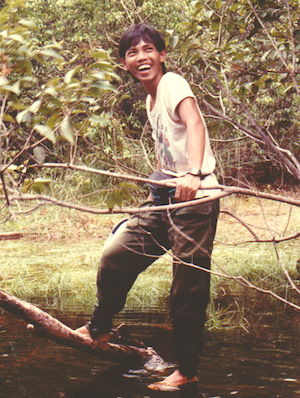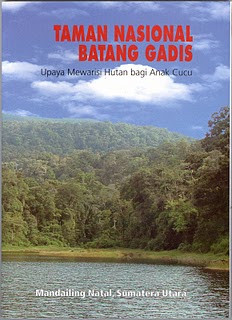The story of the Indonesian Muslim Conservation Movement
May 6, 2019:
 |
 |
 |
Fachruddin Mangunjaya in his first environment job at Tanjung Puting National Park |
It was 1991. Fachruddin Mangunjaya was in his early 20s and had recently started his first conservation job with WWF-Indonesia in Jakarta. He was looking through a filing cabinet for some background papers when the label on one of the folders caught his eye. It said “RELIGIONS AND CONSERVATION.”
He was curious: he had never thought the two things were connected enough to have a folder for them. When he opened the folder there was just one document inside. That document would change his life. It would also save the lives of many endangered animals.
The document was The Assisi Declarations, initiated by HRH the Duke of Edinburgh, WWF-International and the team that became The Alliance of Religions and Conservation (ARC), led by Martin Palmer.
It contained messages on the links between humanity and nature from Buddhism, Christianity, Hinduism, Islam and Judaism. And when it was compiled for WWF’s 25th Anniversary celebrations in Assisi, Italy in September 1986 there was nothing like it anywhere in the world.
Mangunjaya is a Muslim and the son of a Muslim cleric. So he turned naturally to the Muslim section, written by Dr Abdullah Omar Nasseef, Secretary General of the Muslim World League.
The document began with the words: “The essence of Islamic teaching is that the entire universe is Allah's creation. Allah makes the waters flow upon the earth, upholds the heavens, makes the rain fall and keeps the boundaries between day and night.” And as he read he was brought back through the years, to something that happened when he was a child.
When he was a small boy growing up in a remote part of Kalimantan he went with his friends for a swim in the local river, surrounded by tropical rainforest. There was a turtle’s egg on the beach. He brought it to show his father. “Can we eat it?” he asked in excitement. “No”, said his father. And he explained how Muslims should not consume “animals that have two natures, one of the land and one of the water.”
 |
 |
 |
Batang Gadis National Park, Sumatra |
The teaching was from what is called The Yellow Book, Sabilal Muhtadin (“the way for people who are guided to explore religious matters”), an eighteenth century text that has become a reference for many Muslims in Southeast Asia. It was written by Sheikh Muhammad Arsyad al-Banjari, a scholar from southern Kalimantan who lived from 1122-1227 hijriyah (1710-1812).
The book names many animals as haram, or forbidden to eat, including animals with claws and sharp nails like eagles and cats, as well as turtles, frogs, crocodiles, and primates including the orang-utans and proboscis monkeys. It has become vital for contemporary Muslim conservationists working to protect all of those animals and others.
As a teenager he worked in a national park about seven hours from his home. He did it to improve his English by talking with foreign volunteers but he ended up being fascinated by conservation.
“Everyone does orangutans” his supervisor had told him when he started university. “What’s your second choice?” Leeches, he said. And before he was 20 he was an honorary member of the British Association of Leech Scientists. With a PhD in Environmental Management and National Resources he found himself in WWF, thinking for the first time about the links between two sides of his life – Islam and protecting animals.
He went on to support many key Islamic environmental programmes in Indonesia. To put it in context, Indonesia is the world’s most populated Muslim-majority country. It has 217 million Muslims, 83% of the population. Its endangered wild animals includes Sumatran tigers, Javan leopards, orangutans, anoas (small wild buffaloes), Indian tapirs, Sumatran rhinoceros and elephants, and sun bears.
 |
 |
 |
Many Muslim partners around the world have engaged with Greening the Hajj outreach |
All have benefitted from the bans, or fatwas, against killing threatened and endangered wild animals and protecting their habitat that Dr Mangunjaya has, with ARC’s support, helped Muslim clerics introduce.
WWF had a role in all these programmes. In its hosting of the 1986 event, in its guiding (through providing active and interested trustees and giving some funding), of ARC’s work in Indonesia and elsewhere, and in whoever did the filing, long ago in the Jakarta office – we have on the occasion of WWF’s 60th anniversary prepared a chronology of the development of the work on Islam and the environment in Indonesia. Work that is inspiring others, in Malaysia and elsewhere, to create similar programmes.
CHRONOLOGY OF EVENTS
1986 The Muslim Declaration on Nature is published for WWF’s 25th Anniversary. It was one of five faith declarations on Humanity and Nature, which became known as The Assisi Declarations. It was the first time that such a statement had been made and it had a huge impact. Including on Dr Mangunjaya, who as described above, found it a few years later in a file and it changed his life.
1995 The Alliance of Religions and Conservation is launched at Windsor Castle, UK. ARC, founded by HRH Prince Philip, today incorporates eleven religions — as well as Muslims it works with Baha’is, Buddhists, Christians, Daoists, Hindus, Jains, Jews, Shinto, Sikhs and Zoroastrians. About 88 percent of the world’s population are faith believers.
1995 Islamic statement on nature is published.
1999: One student one tree policy introduced in Indonesian pesantrans, or Muslim boarding schools
2003: Batang Gadis National Park, Sumatra. IN 2003 Conservation International Indonesia initiated an effort to conserve a large tract of forest in the Batang Gadis watershed area in Northern Sumatra – rich in wildlife, home to the Sumatran tiger and other wild cats, severely threatened by logging. It realised it would need local allies and approached the most influential person in the community, the imam. “The process to get Batang Gadis its National Park status was long and involved a lot of lobbying and negotiating. But by the end of 2003, more than 13,000 Muslim students (santri) and ulama (Muslim leaders), together with other society members, gathered for the declaration of Batang Gadis National Park, which covered an area of 108,000 hectares or more than 25% of the total forest in the regency. Because of this established park, the Batang Gadis River will be protected from logging and mining industries, and will remain in its natural condition.”
2005: First book on Islam and Nature Conservation in Bahasa Indonesia. This book was an important part of the growing national awareness to engage with the religious groups in Indonesia on nature conservation. It was written by Dr Mangunjaya.
2008, Bogor, Indonesia: Pesantrens programme to protect national parks: A large number of pesantrens, representing nearly 32,000 students launched a programme to protect national parks in Indonesia. The intention was to protect the Gunung Gede Pangrango and Halimun-Salak national park through the implementation of hima. The Rufford Foundation was one of the key funders: Dr Mangunjaya was one of the project leaders.
2008, Aceh pesantrens replanting forest land initiative: Some key pesantrens in Aceh – the province best known internationally for its devastating civil war and the damage from the 2006 tsunami – undertook operations to replant forest land. The land had been devastated in the war when many villages were burned down and vacated so that there was no one to watch over the forest – meaning that overseas companies, army soldiers and others could cut down vast swathes of forests, selling the hard wood illegally in international markets. Dr Mangunjaya was part of the team training the clerics in Aceh, together with WWF, Timber for Aceh, Conservation International and IFEES
2008, Malaysia mosque turtle conservation outreach: Some 500 mosques in the Malaysian state of Kuala Terengganu preached about turtle conservation in a bid to raise awareness on the species. It was part of a project designed by local NGO Mekar and WWF-International to help turtles around three fishing communities starting with a workshop organised with imams from various mosques on integrating conservation messages in their ceramah, Maghrib lectures and Friday sermons.
2009: Muslims created an Islamic Seven Year Plan on the Environment. It was launched at Windsor Castle during a major event attended by HRH The Prince Philip and then secretary-general of the United Nations Ban Ki-moon. It was one of thirty-one long term environment plans launched by nine faiths. The aim was “to mobilize the resources of the Islamic Umma to contribute to the ongoing global efforts dealing with Climate Change.” Dr Mangunjaya attended, with several other Muslim climate change leaders.
2011, November: The Green Guide to Hajj was launched at Assisi. This was done in conjunction with UK based Muslim NGO Global One and supported by Muslim organisations in Indonesia, Nigeria and elsewhere.
2012: Green Hajj programme launched in Indonesia. The Bahasa Indonesian version of The Green Guide to Hajj – the Haji Ramah Lingkungan – was published in print and as a download. The first edition of 1,000 copies was distributed through a travelling exhibition launched in Binjai, North Sumatra in September 2012 just as a large group of 263 Indonesian Muslims were about to begin their Umrah. Each pilgrim was presented with a copy of Haji Ramah Lingkungan by the Mayor of Binjai. Many of them completed questionnaires designed to raise awareness of key areas of environmental harm such as using and discarding plastic bottles and bags as they walk. The exhibition was later displayed at the mosque of Majelis Zikr Azzikra, in Bogor, West Java where an estimated 10,000 people attended in 24 hours. This initiative was led by Dr Mangunjaya and supported by ARC.
2014: Fatwa on wildlife launched in Indonesia.2014: Fatwa on wildlife launched in Indonesia. ARC, through Dr Mangunjaya, facilitated dialogue between conservation groups, including WWF Indonesia, and the Indonesian Council of Ulama (MUI). This resulted in the MUI issuing a fatwa, or Muslim edict, requiring the country’s 200 million Muslims to take an active role in protecting threatened species including tigers, rhinos, elephants and orangutans. The fatwa, which was widely acclaimed in the world’s media, was one of the first of its kind in the world and was accompanied by an education programme to help clerics and communities put it into practice.
2014, February: The first International conference on greening the Hajj, in Kuala Lumpur. The conference was organized by ARC’s Islamic Programmes advisor, Dr Husna Ahmad, author of “The Green Guide for Hajj” and the Islamic Education Foundation in Malaysia. The conference heard of impressive steps already achieved, including reducing the number of days people stay in the desert (using scarce resources), cutting pilgrim numbers overall and recommending a new Muslim tradition of going on Hajj ONLY ONCE in your life to show how devout you are.
2015: Environmental fatwa awareness programme in Sumatra and West Java. This was led by Dr. Mangunjaya through ARC and with WWF Indonesia as a key partner.
2015: Malaysia’s first wildlife trade fatwa: this was based on the Indonesian fatwa, passed by religious authorities from the state of Terengganu and facilitated by the local NGO, Rimba.
2015: Islamic Declaration on Global Climate Change. This was launched in Istanbul on August 18, 2015. The declaration was submitted to support the Paris Agreement. Dr Mangunjaya was a member of the drafting team.
2016: ARC begins working with Rimba to train Muslim clerics and spread awareness about the wildlife fatwa. USFWS provided key funding
2016, April: A Malaysian documentary film about Muslims and ecology was released for Earth Day. The film called on Muslims to take better care of wild animals. Its title Harimau Selamanya means “Tigers Forever” and tackles the story of the almost extinct Malayan tiger panther tigris ssp jacksoni. The film highlights the tenets of Islam, which forbid Muslims from hunting any species to extinction. Such acts are declared as ‘haram’ and every follower is duty-bound as ‘caliphs’ to protect Allah’s creations. The Malayan tiger is now Critically Endangered on the IUCN Red List of Threatened Species.Latest figures suggest there are only 80-120 mature individuals alive in the wild, which means they are facing extinction.
2016, December. Launch of the Green Hajj App . This was done at the UNFCCC COP 22, Marrakesh, Morocco. It was led by Dr Mangunjaya in collaboration with Global Muslim Climate Network.
2016: Indonesia's highest Islamic authority (MUI) issued a fatwa prohibiting deliberate burning of forests issued a fatwa prohibiting deliberate burning of forests and peatlands. Forest burning has devastated large areas of Indonesia and causes air pollution which affects countries around the region. This followed a request by Indonesia’s Ministry of Forests and the Environment, and was facilitated by the success of the wildlife fatwa.
2017, December UNEP draft of the UN Strategic engagement with Faith-based organisations. This included strong plans for Muslim engagement.
2018: Environment fatwa awareness funding. Three more years of funding for fatwa awareness work in Sumatra and West Java was approved by DEFRA and USFWS.
2019, March: Indonesian Muslims represented in the UNEP Faith for Earth Dialogue. UNEP’s aim was to engage religious groups to be more involved in environmental actions. Dr Mangunjaya was invited to present on Islamic perspectives for sustainable consumption.
|

